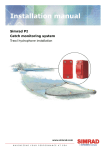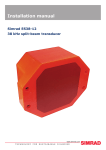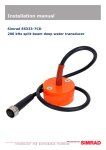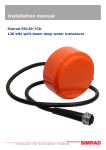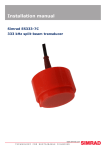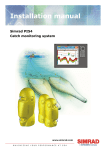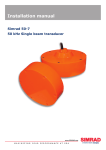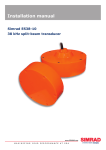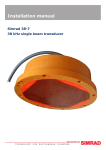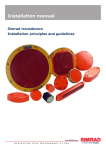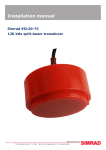Download Simrad PI PURSE SEINE HYDROPHONE - INSTALLATION REV D Installation manual
Transcript
Installation manual Simrad PI Catch monitoring system Purse seine hydrophone installation www.simrad.com MAX IMIZI NG YOUR PER FOR MAN CE AT SE A 851-164149 / Rev.D Simrad PI Catch monitoring system Purse seine hydrophone installation Document information Rev Date Written by Checked by Approved by Rev.D 03.06.05 RBr KRa KRa Information reorganized. © 2005 Simrad AS. All rights reserved. ISBN 82-8066-054-2 No part of this work covered by the copyright hereon may be reproduced or otherwise copied without prior permission from Simrad AS. The information contained in this document is subject to change without prior notice. Simrad AS shall not be liable for errors contained herein, or for incidental or consequential damages in connection with the furnishing, performance, or use of this document. The equipment to which this manual applies must only be used for the purpose for which it was designed. Improper use or maintenance may cause damage to the equipment or injury to personnel. The user must be familiar with the contents of the appropriate manuals before attempting to operate or work on the equipment. Simrad AS disclaims any responsibility for damage or injury caused by improper installation, use or maintenance of the equipment. If you require maintenance on your Simrad equipment, contact your local dealer. You can also contact Simrad using the following e-mail address: [email protected] Installation manual Introduction . . . . . . . . . . . . . . . . . . . . . . . . . . . . . . . . . . . . . . . . . . . . . . . . . . . . . . . Installation precautions . . . . . . . . . . . . . . . . . . . . . . . . . . . . . . . . . . . . . . . . . . . . . . Considerations . . . . . . . . . . . . . . . . . . . . . . . . . . . . . . . . . . . . . . . . . . . . . . . . . . . . . Pre-installation check-list . . . . . . . . . . . . . . . . . . . . . . . . . . . . . . . . . . . . . . . . . . . . Optimal location of purse seine hydrophones . . . . . . . . . . . . . . . . . . . . . . . . . . . . . Coverage area, orientation and tilt . . . . . . . . . . . . . . . . . . . . . . . . . . . . . . . . . . . . . . Mounting arrangement . . . . . . . . . . . . . . . . . . . . . . . . . . . . . . . . . . . . . . . . . . . . . . . Dual hydrophone installation . . . . . . . . . . . . . . . . . . . . . . . . . . . . . . . . . . . . . . . . . . Hydrophone protection . . . . . . . . . . . . . . . . . . . . . . . . . . . . . . . . . . . . . . . . . . . . . . Hydrophone cable . . . . . . . . . . . . . . . . . . . . . . . . . . . . . . . . . . . . . . . . . . . . . . . . . . Installation drawings . . . . . . . . . . . . . . . . . . . . . . . . . . . . . . . . . . . . . . . . . . . . . . . . 1 2 3 7 9 10 13 16 18 21 26 851-164149 / Rev.D III Simrad PI Catch monitoring system / Purse seine hydrophone IV 851-164149 / Rev.D Installation manual Introduction The purpose of this document is to provide general guidelines for the installation of the PI hydrophone for purse seining. Note: If your vessel shall be fitted for trawl operations, DO NOT install the hydrophone(s) as explained in this document! Order numbers Purse hydrophone, complete: HYD-202711 Purse hydrophone, without cable gland: HYD-205075 Topics 851-164149 / Rev.D → Precautions, page 2 → Considerations, page 3 → Pre-installation checklist, page 7 → Location, page 9 → Coverage area, orientation and tilt, page 10 → Mounting arrangement, page 13 → Dual hydrophones, page 16 → Hydrophone protection, page 18 → Hydrophone cable, page 21 → Installation drawings, page 26 1 Simrad PI Catch monitoring system / Purse seine hydrophone Installation precautions Caution: 2 The following precautions must be observed. Failure to do so can result in damage to the hydrophone which may render the PI Hydrophone system inoperative. 1 Observe the maximum allowable torque warning of 5 Nm when tightening the hydrophone studs. 2 Use only M8x35 socket countersunk head screws for mounting the hydrophone. 3 Secure threaded hydrophone hardware with Loctitet 270 or the equivalent. 4 Do not paint the hydrophone. 5 Do not sand-blast, power or steam wash the hydrophone. 6 Do not scrape the hydrophone with metal or other hard objects that may damage the polyurethane sheathing. 7 Do not strike the hydrophone. 8 Do not expose the hydrophone to harsh chemicals. 9 Do not perform hot work in the vicinity of the hydrophone. 10 Do not lift the hydrophone by its cable. 851-164149 / Rev.D Installation manual Considerations Correct installation of the PI hydrophone is vital to the system’s performance. Several variables must be taken into consideration, the most important of which is the vessel’s construction. This guide is for use in selecting the best location for the hydrophone and includes a brief description of areas to be avoided. Note: Simrad strongly suggests that this information is read thoroughly, and that the instructions are understood and followed. Proper hydrophone placement is difficult to achieve, but essential for correct system operation. Depth Water just below the sea surface contains a myriad of small air bubbles created by the turbulence of breaking waves. The first five to ten metres may be heavily saturated in moderate seas with the greatest concentration and largest bubbles closest the surface. Air bubbles disrupt sound waves in water. The degree to which they absorb and reflect such energy vary, but in some cases they can block hydrophone reception. It is therefore recommended to mount the unit as deep as possible. Pounding danger When a vessel is in ballast and pitching in heavy seas, it is important that the hydrophone is not lifted out of the water. Should a vessel pound so heavily that the hydrophone be exposed, sound reception will be interrupted and the unit may be damaged on impact. The boundary layer The flow of water in the immediate vicinity of the hull of a moving vessel is known as a boundary layer. This flow is responsible for underwater noise that can disturb hydrophone reception and its thickness is contingent on a vessel’s: • • • • Hull form Size and number of underwater protrusions Velocity Hull roughness The boundary layer is thin (laminar flow) near the vessel’s bow and becomes thicker (turbulent flow) as it moves aft. Laminar flow is smooth with streamlines approximately parallel to the hull and contributes relatively little to noise created by flow. Conversely, turbulent flow is more disorderly and in turn contributes to a greater extent. 851-164149 / Rev.D 3 Simrad PI Catch monitoring system / Purse seine hydrophone Boundary water layers: (A) = Turbulent flow (B) = Laminar flow (C) = Air bubbles in the water Air bubbles may also be introduced into the boundary layer. If the vessel’s hull has little flare and is relatively narrow, bubbles may escape to the sea surface without incident. On the other hand a wide, flat hull with minimal deadrise is prone to trapping air bubbles no matter how little flare it has. Regardless of a vessel’s hull form, hydrophones are generally recommended to be installed on the forward part of the hull to minimising the influence of both turbulence and air bubbles. Bulbous bow The bulbous bow may be an acceptable hydrophone location. Should this position be chosen, the foremost part of the bulb is often best, but also the most susceptible to pounding. Recommended location of the hydrophone on a bulbous hull: (A) = Thruster (B) = Hydrophone location 4 851-164149 / Rev.D Installation manual Propeller noise A vessel’s main propeller is the dominant source of underwater acoustic noise. When ever possible, hydrophone(s) should be located as far a way as possible from the main propeller and never closer than ten meters. Hydrophone(s) should not be mounted in the direct acoustic path (line-of-sight) of the main propeller unless absolutely necessary. The primary cause of propeller noise is cavitation (small bubbles generated by the partial vacuum created by the blades as they pass through the water). The resulting underwater acoustic noise from cavitation is normally weakest on the side of the vessel were the propeller blades rotate toward the surface and most pronounced on the side were they rotate toward the bottom. Most vessels have clock-wise rotating propellers resulting in their port sides being less effected by cavitation induced noise than their starboard. To minimise the negative effect of cavitation noise on hydrophone performance, installation is generally recommended as follows: • Single hydrophone - if only one hydrophone is to be installed on a vessel with a clock-wise rotating propeller, it should be located on the port side of the hull. • Dual hydrophones - if two hydrophones are to be installed, they should be placed on either side of the vessel’s keel. When in doubt about the best fore-and-aft location for hydrophones, they can be placed at different distances from the bow (for example the port hydrophone can be a little further aft than the starboard, approximately three to five meters for a thirty-five meter vessel). When trawling in both deep and shallow water the hydrophones should also be tilted differently with respect to each other. The hydrophone that is closest to the propeller should have the greatest tilt and be located on the port side of the hull for a vessels with clock-wise rotating propellers. Bow/sternthruster noise Bow and sternthruster operation may severely effect hydrophone reception. Hydrophone installation closer than four meters to either is strongly discouraged. 851-164149 / Rev.D 5 Simrad PI Catch monitoring system / Purse seine hydrophone When not in operation, bow/sternthruster tunnels create turbulence and hence underwater noise when a vessel is under way. Also, as a vessel pitches in heavy weather, thruster tunnels may fill with air or aerated water which can disturb hydrophone reception when released. Hydrophone installation should take into regard the noise and down stream disturbances found around and aft of thrusters. Note: Hydrophone installation must take into regard the noise and down stream disturbances found around and aft of thrusters. Noise from protruding objects and other sources The primary sources of underwater disturbance (other than a vessel’s main propeller and bow/sternthruster) that affect hydrophone reception are: • Main or bilge keels • Zinc anodes • Cooling elements protruding from the hull • Equipment such as sonar hydrophones and pitot tubes • Sea chests • Overboard discharges • Dents in the hull All appendages to the hull, indentations and pipe outlets are potential sources of underwater noise. They may act as resonant cavities amplifying noise at certain frequencies, create cavitation or turbulence. Hydrophones should not be located in the vicinity of such objects and especially not immediately aft of them. Minimum distance to sonar and echo sounder transducers To avoid interference, PI hydrophone(s) must be installed as far away as possible from other sources of underwater acoustical energy such as active sonars and echo sounder transducers. Hydrophones should be placed at least two meters from such equipment when ever possible and distances of less than one meter avoided. Hydrophones installed in close proximity to underwater acoustical sources should be located as far aft as possible from them, and most importantly, not be subjected to direct (frontal) transmission from such equipment. Drop keel In the event the vessel is equipped with a drop keel, the hydrophones should be mounted aft of it. The choice between installing a one, or two hydrophone system should be based on the same horizontal and vertical coverage requirements for vessels operating under similar conditions with fixed keels. 6 851-164149 / Rev.D Installation manual Pre-installation check-list Choosing the optimal locations for hydrophones is not always easy, but decisions made at this phase of the installation process are critical to future system performance. Determining the best configuration for a given vessel often involves a compromise between contradicting requirements. To aid in this evaluation process Simrad recommends that this installation manual be read thoroughly and the following check list completed before deciding on a final installation strategy for the PI system. 1 Hydrophones do not have a direct line-of-sight to the main propeller and are placed where the vessel’s hull protects them from underwater acoustic noise as well as possible. 2 Hydrophones must always have an unobstructed line-of-sight to the sensors attached to the gear for the system to operate properly. 3 The distance from the main propeller to the hydrophones should be greater than ten meters. A separation of less than ten meters can reduce system range significantly. 4 If thrusters are installed, hydrophones should be located at least four meters from them. 5 Avoid locating hydrophones behind thrusters where air bubbles from their tunnels generated when the vessel pounds can block sensor signals. 6 Hydrophone should not be placed forward of other underwater acoustic equipment and preferably behind it as far away as possible, distances of less than one meter should be avoided. 7 There should never be possible sources of underwater acoustic noise placed in front of hydrophones. 8 Remember that hydrophones are to be mounted with their long axis up (in the vertical plane). 9 Hydrophones installed in blisters should be located away from the vessel’s keel and as deep as possible on the hull. 10 Hydrophones installed in shoes along the vessel’s keel should be mounted as deeply as possible. 11 Hydrophone cables that are run in conduit along the outside of the vessels hull should be arranged as to produce the least amount of underwater acoustic noise as possible. 12 Blisters and shoes should be as streamlined as possible and have all of their corners rounded to minimize the generation of underwater acoustic noise. 851-164149 / Rev.D 7 Simrad PI Catch monitoring system / Purse seine hydrophone 8 13 Conduit used to run hydrophone cables in the interior of a vessel’s hull should extend well over its water line. 14 If you install both trawl and purse seine hydrophones, do not confuse the two types. The Trawl hydrophones are marked with order number 314-205250, while the Purse seine hydrophones are marked with order number 314-202275. 15 Other well-founded information or experience regarding hydrophone installation be available should also be evaluated even though not directly mentioned in these instructions. 851-164149 / Rev.D Installation manual Optimal location of purse seine hydrophones The most influential factors effecting hydrophone reception common to most vessels are: • Noise from cavitation generated by the main propeller. • Air bubbles in the water around the hydrophone which impede acoustic signals. • Noise from other acoustic equipment mounted in close proximity. Taking these main sources of disturbance into consideration, the generally recommended location for mounting a single hydrophone is approximately one third the vessel’s water-line length from the bow. Installations requiring the use of two hydrophones may position the first as described above and the second forward of the bow thruster in conjunction with the transducer shoe for the echo sounder. Both hydrophones must be located at least four meters from the bow thruster. Optimal hydrophone placement differs from vessel to vessel. Variables effecting hydrophone performance must be understood so that the best location may be chosen given a vessel’s design and particular operation. The illustration shows the recommended fore (B) and aft (A) locations for single hydrophone locations. For a dual installation, both are used. (L) is the total length of the hull measured at the waterline. 851-164149 / Rev.D 9 Simrad PI Catch monitoring system / Purse seine hydrophone Coverage area, orientation and tilt General Once the fore and aft placement of the purse seine hydrophone is decided, it is equally important to carefully consider its horizontal and vertical orientation. Hydrophone orientation can have a large influence on system performance. The hydrophone’s beam sensitivity is concentrated within a 90_ horizontal and -30_ vertical sector. Both keel and hull installations are to be located on the side of the vessel that the seine is shot. Note: These installation instructions and related drawings are for vessels shooting and pursing to STARBOARD. Horizontal coverage area When the seine is normally located forward of the starboard beam when pursing the following information should be taken into consideration: 1 When the seine is pursed in the sector from approximately 000_ to 120_ relative to the bow, the hydrophone should be installed at an angle of 70_ to the vessels centre line. 2 When the seine is pursed in the sector from approximately 030_ to 150_relative to the bow, the hydrophone should be installed at an angle of 90_ to the vessel’s centre line. The most important elements with regard to the horizontal coverage area of the hydrophone are: 10 1 An unobstructed line-of-sight to the PI sensor(s) attached to the purse seine. 2 The hydrophone is directed at the middle of the net when pursing. 3 Two hydrophones may be used for applications requiring a large coverage area. 851-164149 / Rev.D Installation manual Figure 1 Horizontal coverage area The illustration shows a hydrophone installed at an angle of 70 degrees to the vessel’s center line. (A) = The PI hydrophone (B) = The horizontal coverage area Vertical coverage area The hydrophone has a vertical beam width of -30_ and should be tilted so that the most important part of the seine is adequately covered. Tilt should be no less than -15_ in most instances with the optimal tilt angle depending on the size (length/depth) of the seine in use. Heeling of the vessel after the seine is set must also be taken into consideration. For a large purse seine (about 1000m or longer) the recommend a tilt angle is -15_ plus the estimated angle of heel when the net is set. For smaller and deeper seines it may be necessary to increase the tilt angle. 851-164149 / Rev.D 11 Simrad PI Catch monitoring system / Purse seine hydrophone Tilt angle The tilt angle is a function of net length and depth and may be estimated as follows: α = - [arctan (depth/length * π) - 15_+ β] α = tilt angle β = angle of heel (to port) after deploying the purse seine to starboard The following table gives some examples of recommended tilt angles for common size pure seines: Recommended tilt angles Net length/depth in meters 250 / 50 350 / 100 650 / 150 850 / 180 1500 / 200 2000 / 200 Recommended tilt angle * --15_ --25_ --20_ --20_ --15_ --15_ *The tilt angle should be increased accordingly if the vessel heels after the seine is shot. Tilt angles of less than --15_ are not recommended. 12 851-164149 / Rev.D Installation manual Mounting arrangement The PI purse hydrophone are delivered ready for installation in either freestanding or keel mounted shoes (which are to be built by the shipyard responsible for the installation). Several alternatives with corresponding detailed drawings have been included in this manual to cover the majority of installation options available. Information regarding through-hull penetration is also described to compliment the rules and regulations of the respective vessel’s classification society. Referenced drawings 851-164149 / Rev.D → PI Purse hydrophone, outline dimensions, page 27 → PI Purse hydrophone, cutout, page 28 → Purse hydrophone, keel mounted, steel or aluminum, page 29 → Purse hydrophone, keel mounted, sandwich or wood, page 32 → Purse hydrophone, blister installation, page 35 13 Simrad PI Catch monitoring system / Purse seine hydrophone Keel mounted shoes The hydrophone shoe may be keel mounted to avoid creating an appendage to the hull which may foul the purse wire. Keel mounted hydrophone shoe: (A) = Tilt angel (B) = Vertical coverage area (C) = Keel mounted hydrophone with fairing Should this solution be chosen, the following must be taken into consideration: • The hydrophone must have an unobstructed line-of-sight to the PI sensor(s) attached to the seine. • The centre of the hydrophone’s beam must be directed as much as possible toward the bottom of the net where the PI sensors are located. The tilt angle must be increased with regard to the expected heel of the vessel. • For a short and deep seine a tilt angle (A) of 20_ to 25_ is recommended. For a short and shallow or large seine a 15_ tilt angle may be best. • If monitoring of the headline under pursing is desired the hydrophone should not be tilted more than 15_. • The hydrophone shoe must be mounted as deep as possible on the keel, but not so deep that it may be damaged while docking. • The hydrophone shoe must be streamlined to avoid creating turbulence and underwater noise. • For applications that require extensive coverage, regardless of net size, several hydrophones may be installed with different tilt angles. 14 851-164149 / Rev.D Installation manual Free standing hydrophone in blister If there is no risk that hull protrusions will be fouled by the purse wire, mounting the hydrophone in a freestanding blister is a viable option. Free standing hydrophone in blister: (A) = Tilt angel (B) = Vertical coverage area (C) = Free standing hydrophone in blister (pipe diameter 200 to 250 mm) (1) = Approximately 400 mm, minimum 250 mm is required (2) = Must exceed 700 mm. Should this solution be chosen, the following must be taken into consideration: • The centre of the hydrophone’s beam must be directed as much as possible toward the bottom of the net where the PI sensor(s) are located. The tilt angle should be increased with regard to the expected heel of the vessel. • For a short and deep seine a tilt angle (A) of 20_ to 25_ is recommended. For a short and shallow or large seine a 15_ tilt angle may be best. • If monitoring of the headline under pursing is desired the hydrophone should not be tilted more than 15_. • For applications that require extensive coverage, regardless of net size, several hydrophones may be installed with different tilt angles. 851-164149 / Rev.D 15 Simrad PI Catch monitoring system / Purse seine hydrophone Dual hydrophone installation Large vessels and operations requiring a greater than normal coverage area can install two hydrophones with a vertical and horizontal overlap. Hydrophone selection is made with the help of a switch located in the wheelhouse. To reduce the possibility of interference from air bubbles and underwater noise when reversing propulsion or using thrusters the two hydrophones should be located at least five meters from each other in the fore and aft plane. It is also recommended to install the two hydrophones with a slightly different tilt angles so that a larger vertical sector may be covered. Vessels equipped with a bowthruster or bulbous bow can install the first hydrophone forward of the bowthruster on the bulbous bow and the second aft of the bowthruster. Dual hydrophone installations may be either keel mounted or installed in free-standing blisters. Horizontal coverage areas When the seine is normally located forward of the starboard beam when pursing the following information should be taken into consideration: • When the seine is pursed in the sector from approximately 000_ to about 130_ relative to the bow, the foremost hydrophone should be installed at an angle of 50_ and the after 90_ to the vessel’s centre line. • Should special circumstances require coverage outside the standard 000_ to 130_ sector the hydrophones may be installed accordingly. (A) = Aft hydrophone, (B) = Forward hydrophone (C) and (D) = Horizontal coverage areas 16 851-164149 / Rev.D Installation manual Vertical coverage areas When the seine is normally located forward of the starboard beam when pursing the following information should be taken into consideration: • The optimal tilt angle for dual hydrophone installations is derived in the same manner as a for single hydrophone installations. Consult the section on Tilt angle for more information. • The hydrophones should be tilted so that the most important part of the seine is adequately covered. Tilting the forward hydrophone -25_ and the after -15_ will provide proper coverage in most instances. • Tilt should be no less than -15_ in most instances with the optimal tilt angle depending on the size (length/depth) of the seine in use. • Heeling of the vessel after the seine is set must be taken into consideration when calculating the tilt angle. 851-164149 / Rev.D 17 Simrad PI Catch monitoring system / Purse seine hydrophone Hydrophone protection Warning: Do not perform hot work near, paint, scrape, hit, pry, force, sandblast, high-pressure wash or otherwise subject hydrophones to excessive force. Installation precautions The following precautions must be observed. Failure to do so can result in damage to the purse seine hydrophone which may render the PI system inoperative. 1 Do not install the hydrophone until all hot work is complete! 2 Do not over-tighten the packing nipple as this could damage the hydrophone’s cable! 3 Observe the maximum allowable torque warning of 5 Nm when tightening hydrophone studs! 4 Use only stainless steel M8x35 socket countersunk head screws for mounting the hydrophone! 5 Secure threaded hydrophone hardware with Loctitet 270 or the equivalent! 6 The PI cabinet should always be connected to the ship’s ground to reduce the effects of electrical interference on the system! Under installation Hydrophones must not be installed until all structural work, specifically welding sandblasting and other potentially harmful operations are completed. If hot work, sandblasting, spay painting or water blasting is to be performed in the vicinity of a hydrophone it must be properly protected. PI hydrophones although very rugged, contain sensitive ceramic elements and electronic circuits and therefore should never be struck, prided, clamped or subject to other types of potentially damaging force as for example over-tightening mounting hardware. Deflection plates Simrad recommends that hydrophones mounted in blisters be protected by rope deflections plates both forward and aft. Such precautions will help protect the hydrophones, especially in the event the vessel passes over a wire, line or net. 18 851-164149 / Rev.D Installation manual Vessels operation in colder climates should weld steel fins and protection plates installed around hydrophones to protect them from being damaged by ice. Detailed drawing must be made specifically to suite each individual vessel in question and the installation performed by an authority with the expertise to do so. Surface protection Maintenance and replacement costs can be reduced if those parts of the hydrophone installation that are open to the sea are protected correctly. Any new metal or original plating involved in the hydrophone installation which has been cut, sand-blasted, welded or otherwise had its protective coating compromised must be thoroughly cleaned and repainted. For steel vessels use polyester primer, undercoat and top-coat according to the manufacture’s instructions, then apply the same anti-fouling paint used on the rest of the hull. Hydrophone face This is Simrad’s list of approved antifouling paints for hydrophone faces. From Jotun Paints, Sandefjord Norway: • Antifouling Seamate HB 33, HB 66 and HB 99 • Racing • Non-stop From International Paints: • Intersleek tie coat + 425 FCS - BXA386/BXA390/BXA391 Grey - HKA563/HKA570/HKA571 Yellow Mix BXA386, BXA390 and BXA391 first, then apply. When dry, mix HKA563, HKA570 and HKA571, apply. From Hempel IFA Coatings AS: • Hempel A/F Classic 76550 From Jotun-Henry Clark Ltd: • Anti-fouling Seaguardian From International Marine Coatings: • Intersmooth 360 Ecoloflex SPC • Micron Ekstra Note: 851-164149 / Rev.D Refer to the manufacturer’s documentation and data sheets for a complete procedure. 19 Simrad PI Catch monitoring system / Purse seine hydrophone Location and marking After installation, the location of hydrophones should be clearly marked on the vessel’s hull (above the water-line) directly over them. This information will help prevent hydrophone damage when dry-docking the vessel. It is very important to amend the docking-plans of larger vessels to also reflect this information so that blocks will not be placed in the vicinity of hydrophones, fins, deflection plates or other associated appendages. After installation / Sea trials Once the installation is complete and the vessel afloat, the system’s performance should be documented. Refer to the appropriate section in the PI Operation manual regarding the measurement of a noise vs. speed curve. 20 851-164149 / Rev.D Installation manual Hydrophone cable The purse seine hydrophone is delivered with a 22 m cable. The cable is fitted with plug that fits the ANT socket on the rear side of the PI Operator Unit. General cable gland guidelines Hydrophone cables are passed through the hull using approved cable glands for the type of vessel in question. The standard delivery consists of a steel cable gland that is to be welded to the hull. A bronze cable gland can be delivered as an option for vessels with wood or fibreglass construction. Vessel not to be classified can as an option use a cable gland made of plastic. Note: Simrad strongly recommends that a length of conduit be fitted around hydrophone cable glands made of steel or bronze and extended over the water-line inside the vessel. This precaution reduces the danger of flooding in the event of gland failure and hydrophones installed in this manner are also easier to replace. Some vessels may experience difficulties finding suitable areas of the hull for mounting hydrophone cable glands due to existing water tanks, concrete ballast or other obstacles. A possible solution in such cases is to run the hydrophone cables in a steel conduit aft along the hull until a suitable cable gland location is available. The respective cable gland can then be installed as described in the following instructions. Note: Simrad takes no responsibility for the correct installation of cable glands, associated hull modifications and/or structural support of hydrophone cable penetration. These activities are subject to individual approval by the respective classification society for the vessel in question. Order numbers Steel hull cable gland kit: 599-202216 Wood/GRP hull cable gland kit: 119-038200 Small vessel cable gland kit: 599-202182 851-164149 / Rev.D 21 Simrad PI Catch monitoring system / Purse seine hydrophone Cable gland installation for steel hulls The cable gland kit for steel vessels is included with standard deliveries. The drawing shows a single hydrophone, but normally a typical installation includes two hydrophones with respective cables spliced in a junction box and run to the wheelhouse in a conduit. Cable gland for steel hull vessels. (A) = Steel conduit (B) = Stuffing tube, DNV approved carbon steel st52.3 (C) = Washers, 24 x 8 x 2 mm (D) = Rubber gasket (E) = Packing nipple. Make sure that you do not damage the hydrophone cable by tightening the packing nipple too hard! (F) = Cable to the PI Operator unit (or a junction box) The gland gland kit includes all of the necessary parts needed to install the unit excluding screws. 22 851-164149 / Rev.D Installation manual Gland installation for wood or GRP hulled vessels A bronze cable gland kit is available for wood and GRP vessels. This kit is not included in the standard delivery, and must be ordered separately. The drawing shows a single hydrophone, but normally a typical installation includes two hydrophones with respective cables spliced in a junction box and run to the wheelhouse in a conduit. Cable gland for wood and GRP hulls. (A) = Packing nipple. Make sure that you do not damage the hydrophone cable by tightening the packing nipple too hard! (B) = Washers (C) = Rubber gaskets (D) = Hole diameter 28 mm (E) = Steel conduit (F) = Hydrophone cable The gland gland kit includes all of the necessary parts needed to install the unit excluding screws. Simrad recommends that a one inch conduit (that the hydrophone cable will be run through) with an inside threaded diameter of three-quarter inches be attached to the gland’s packing nipple. This connection must be watertight, and the conduit must extend to over the vessel’s water line and terminated as described for steel hulled vessels. 851-164149 / Rev.D 23 Simrad PI Catch monitoring system / Purse seine hydrophone Cable gland installation for smaller vessels Cable glands made of plastic for those smaller vessels that do njot need to be classified are optional equipment for standard deliveries. This cable gland kit is not included in the standard delivery, and must be ordered separately. The drawing shows a single hydrophone, but normally a typical installation includes two hydrophones with respective cables spliced in a junction box and run to the wheelhouse in a conduit. Hydrophone cable gland for small vessels. (A) = Packing nut (bronze). Ensure that you do not to damage the hydrophone cable by tightening the packing nut too hard! (B) = Rubber gasket (C) = Plastic disk (D) = Rubber gasket (E) = Stuffing tube (F) = Backing nut (bronze) (G) = Backing washer (plastic) (H) = O-ring 42.5 x 3.0 N (I) = O-ring 39.5 x 3.0 N (J) = Hydrophone cable Stuffing tube hole diameter: 36 mm ±1.5 mm. Apply ample amount of sealant between the backing washer (H) and the hull plate. The cable gland kit contains all the listed parts, except the sealant. Note: 24 The two O-rings must be clean, in good condition and free of cuts or other defects which could affect their water-tight integrity. 851-164149 / Rev.D Installation manual Splicing If you need to cut the cable, you must splice it correctly. Note: DO NOT solder the wires together with only electrical tape for insulation, as this will result in electrical noise and reduced operational performance. To splice the cable, use a metal junction box. The chassis of the junction box must be grounded, but the cable shielding must NOT be connected to the junction box ground. Note: Make sure that you connect the cables 1:1! The red cable in the “input” cable MUST be connected to the red cable in the “output” cable etc. Cable specification If extension cables are used, these must be supplied by the installation shipyard. The following specifications must be regarded as a minimum: 2 x 2 x 0.5 mm2 / Twisted pairs / Overall braided Observe the information regarding cable splicing. Grounding and shielding Cable shielding must be continuous. The shielding is terminated in the cabinet and must not be grounded in the junction boxes. In order to minimize electrical interference, Simrad strongly recommends that the hydrophone cable is installed in a metal conduit between the hydrophone and the PI cabinet. 851-164149 / Rev.D 25 Simrad PI Catch monitoring system / Purse seine hydrophone Installation drawings Observe the following drawings. The drawings are also available on electronic format (DWG or PDF), consult your local dealer. 26 → PI Purse hydrophone, outline dimensions, page 27 → PI Purse hydrophone, cutout, page 28 → Purse hydrophone, keel mounted, steel or aluminum, page 29 → Purse hydrophone, keel mounted, sandwich or wood, page 32 → Purse hydrophone, blister installation, page 35 851-164149 / Rev.D Installation manual PI Purse Seine hydrophone - Outline dimensions 851-164149 / Rev.D 27 Simrad PI Catch monitoring system / Purse seine hydrophone PI Purse Seine hydrophone - Cutout 28 851-164149 / Rev.D Installation manual PI Purse Seine hydrophone - Keel mounted hydrophone, steel hull - Page 1 851-164149 / Rev.D 29 Simrad PI Catch monitoring system / Purse seine hydrophone PI Purse Seine hydrophone - Keel mounted hydrophone, steel hull - Page 2 30 851-164149 / Rev.D Installation manual PI Purse Seine hydrophone - Keel mounted hydrophone, steel hull - Page 3 851-164149 / Rev.D 31 Simrad PI Catch monitoring system / Purse seine hydrophone PI Purse Seine hydrophone - Keel mounted hydrophone, wooden hull - Page 1 32 851-164149 / Rev.D Installation manual PI Purse Seine hydrophone - Keel mounted hydrophone, wooden hull - Page 2 851-164149 / Rev.D 33 Simrad PI Catch monitoring system / Purse seine hydrophone PI Purse Seine hydrophone - Keel mounted hydrophone, wooden hull - Page 3 34 851-164149 / Rev.D Installation manual PI Purse Seine hydrophone - blister installation on steel hull - Page 1 851-164149 / Rev.D 35 Simrad PI Catch monitoring system / Purse seine hydrophone PI Purse Seine hydrophone - blister installation on steel hull - Page 2 36 851-164149 / Rev.D Installation manual PI Purse Seine hydrophone - blister installation on steel hull - Page 3 851-164149 / Rev.D 37 E 2005 Simrad AS ISBN 82-8066-054-2












































